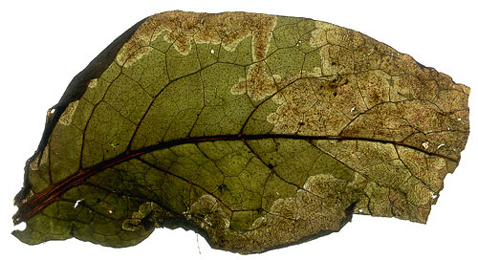|
||||||
| Agromyza
ferruginosa van de Wulp,
1871 [Diptera: Agromyzidae] |
||||||||||||||||||||||||||||||||||||||||||||||||||||||||||||||||
|
Agromyza
ferruginosa
van de Wulp, 1871. Tijdschr. Ent. 14: 205 |
||||||||||||||||||||||||||||||||||||||||||||||||||||||||||||||||
Leaf-miner: A large blotch mine, several larvae feeding together (Spencer, 1972b: 31). A dozen eggs are deposited in a semicircle at the leaf underside. After hatching the larvae eat themselves a communual corridor. After the first moult they begin the making of a very large, dark brown communal blotch, with conspicuous secondary feeding lines (Bladmineerders van Europa). |
||||||||||||||||||||||||||||||||||||||||||||||||||||||||||||||||
Larva: The larvae of flies are leg-less maggots without a head capsule (see examples). They never have thoracic or abdominal legs. They do not have chewing mouthparts, although they do have a characteristic cephalo-pharyngeal skeleton (see examples), usually visible internally through the body wall. The larva is illustrated in Bladmineerders van Europa. Puparium: The puparia of flies are formed within the hardened last larval skin or puparium and as a result sheaths enclosing head appendages, wings and legs are not visible externally (see examples). Hosts in Great Britain and Ireland:
Hosts elsewhere:
Time of year - mines: September. Time of year - adults: Currently unknown. Distribution
in Great Britain and Ireland: Widespread including Surrey (Charterhouse),
Cambridge (Chippenham Fen), Huntingdonshire (Woodwalton Fen) (Spencer, 1972b: 31), Cambridgeshire, North Hampshire, West Kent and West Suffolk (NBN
Atlas). Distribution elsewhere: Widespread in continental Europe including Germany (Mines in BMNH), The Netherlands, Luxembourg (Bladmineerders van Europa), Belgium (Scheirs, de Bruyn and von Tschirnhaus, 1996), Czech Republic, French mainland, Poland and Slovakia (Fauna Europaea). NBN Atlas links to known host species:
British and Irish Parasitoids in Britain and elsewhere:
|
|
|
|
| External links: | Search the internet: |
| Biodiversity Heritage Library Bladmineerders van Europa British leafminers Encyclopedia of Life Fauna Europaea NBN Atlas NHM UK Checklist |
Find
using Google Find using Google Scholar Find images using Google |
| Last updated 07-Oct-2019 Brian Pitkin | ||

